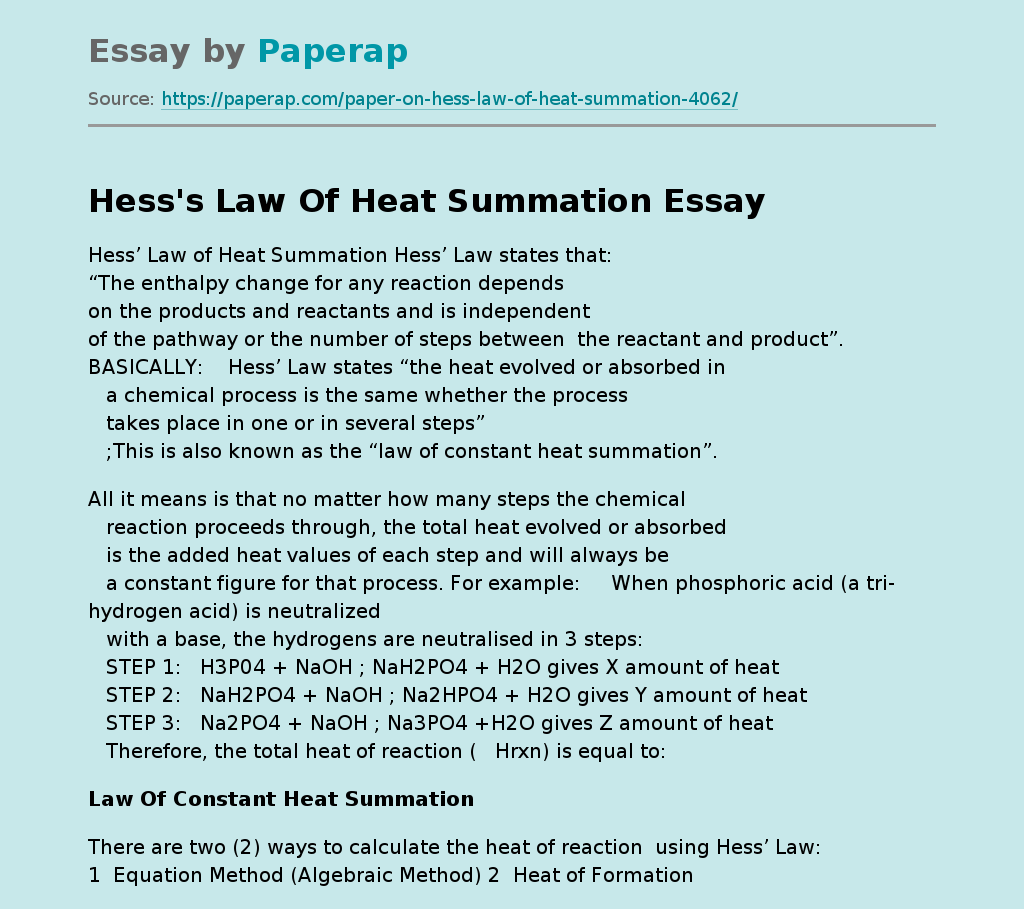Hess's Law Of Heat Summation
Hess’ Law of Heat Summation Hess’ Law states that: “The enthalpy change for any reaction depends on the products and reactants and is independent of the pathway or the number of steps between the reactant and product”. BASICALLY: Hess’ Law states “the heat evolved or absorbed in a chemical process is the same whether the process takes place in one or in several steps” ;This is also known as the “law of constant heat summation”.
All it means is that no matter how many steps the chemical reaction proceeds through, the total heat evolved or absorbed is the added heat values of each step and will always be a constant figure for that process.
For example: When phosphoric acid (a trihydrogen acid) is neutralized with a base, the hydrogens are neutralised in 3 steps: STEP 1: H3P04 + NaOH ; NaH2PO4 + H2O gives X amount of heat STEP 2: NaH2PO4 + NaOH ; Na2HPO4 + H2O gives Y amount of heat STEP 3: Na2PO4 + NaOH ; Na3PO4 +H2O gives Z amount of heat Therefore, the total heat of reaction ( Hrxn) is equal to:
Law Of Constant Heat Summation
There are two (2) ways to calculate the heat of reaction using Hess’ Law: 1 Equation Method (Algebraic Method) 2 Heat of Formation Method (Summation Method) Equation (Algebraic) Method Strategy: add equations for reactions with known enthalpies so that their net result is the desired reaction Sample Problem 1: Use the equations below to determine the enthalpy of reaction for the decomposition of hydrogen peroxide: H2O2(l) H2O(l) + 1/2 O2(g) The equations are: 1 H2(g) + O2(g) H2O2(l) 2 H2(g) + 1/2 O2(g) H2O(l)
Hf = 188 kJ Hf = 286 kJ Solution: Sample Problem 2: Use the following equations: 1 1/2 N2(g) + 3/2 H2(g) NH3(g) 2 1/2 N2(g) + O2(g) NO2(g) 3 H2(g) + 1/2 O2(g) H2O(g) Hf = 46.
0 kJ Hf = +34. 0 kJ Hf = 242. 0 kJ to calculate the enthalpy of reaction for: 4 NH3(g) + 7 O2(g) 4 NO2(g) + 6 H2O(g) Solution: Practice Problem: Calculate the heat of reaction for the oxidation of one mole of ethanol to ethanoic acid: C2H5OH(l) + O2(g) CH3COOH(l) + H2O(l) Use the equations below: C2H5OH(l) + 3 O2(g) 2 CO2(g) + 3 H2O(l) 2 CH3COOH(l) + 2 O2(g) 2 CO2(g) + 2 H2O(l) Hc = 1367 kJ Hc = 874 kJ Enthalpy of Formation (Summation) Method Standard Molar Enthalpy of Formation: ( ) the amount of ____ (absorbed or released) when _________ of a compound is formed from its _________________ in their standard states most enthalpies of formation are ve (__________________)? therefore, most compounds are ___________ stable than the elements they are made from > the enthalpy of formation of an element in its standard state is _____ because it is usually its most stable form! Write the formation equations for: a) methane gas: b) calcium carbonate: c) hydrogen chloride gas: (Look at the Table! ) How to Use Hf to Calculate Hrxn Recall: Hrxn = therefore, Hrxn = ( n Hf products) ( n Hf reactants) Sample Problem 1: Using the enthalpies of formation, calculate the enthalpy of reaction for: CH4(g) + 2 O2(g) CO2(g) + 2 H2O(g)
Practice Problem: Use the summation method to determine the enthalpy of reaction for: 4 NO2(g) + 6 H2O(g) 4 NH3(g) + 7 O2(g) Homework: p. 247 #1316 p. 251 #1720 p. 254 #2124 the following three questions: Use the summation method to calculate each of the following: a) CO2(g) + H2(g) CO(g) + H2O(g) b) C2H5OH(l) + 3 O2(g) 2 CO2(g) + 3 H2O(l) c) C2H6(g) + 7/2 O2(g) 2 CO(g) + 3 H2O(l)
Hess's Law Of Heat Summation. (2019, Dec 05). Retrieved from https://paperap.com/paper-on-hess-law-of-heat-summation-4062/

